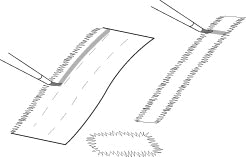| The most time-tested method of attaching paper art in a frame is wheat starch paste and Japanese paper hinges. "Feathering" the edges of the hinge paper by "Wet Tearing" is universally recommended to avoid embossing and cockling of the art. It is also important that the size and number of hinges and strength of the hinging paper be appropriate to the weight and size of the art paper. |
Figure 1. To tear "feathered" edges first wet a line parallel with the chain lines in the hand made Japanese mulberry paper. |

Figure 2. Fold the paper along the wetted line and gently pull it apart making long feathered edges.
|
 Figure 3. Continue wetting and tearing to make hinges with feathered edges on all sides. Figure 3. Continue wetting and tearing to make hinges with feathered edges on all sides. |
|
Figure 4. With a small soft brush, apply the wheat paste to the long fibers of the hinge from the center outward, spreading the fibers like a fan. Only apply the paste to about 6mm (1/4") along the end of the hinge. |

Figure 5. After the paste has dried some (see note below), place each hinge on the back of the art about 6mm (1/4-3/8") down from the edge.
|
|
Figure 6. Cover the hinge with a blotter and a weight and allow to dry 10-15 min. |
Note: Hinges applied too wet will cause the art to cockle, too dry and the paste will not form a strong bond.
After a hinge has been pasted out, look at the pasted area in raking light - wet paste is shiney. When the pasted area appears dull, the hinge is ready to apply to the art. |
